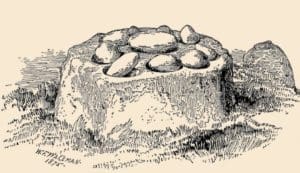360 Degree Video of Cloughmore Stone, County Down

Updated On: April 13, 2024 by Ciaran Connolly
Cloughmore Stone is also referred to and known as “The Big Stone” – which is also the translation for the Irish word Cloughmore – and it is a huge granite boulder which was found about 1,000 feet above the village of Rostrevor, on a relatively flat area of Silurian metasedimentary rock on the side of Slieve Martin that overlooks Carlingford Lough and the Cooling Peninsula in county Lough – so this means that you are not only going to see this old stone that is standing there, but you will also get the chance to receive a great view as well from up there.
A Geological Wonder of Cloughmore Stone
At first glance, the Cloughmore Stone appears as a solitary giant, defiantly defying the elements atop the rugged slopes of the Mourne Mountains. Weighing an estimated 50 tons and standing over 30 feet tall, this impressive granite erratic is believed to have been deposited by glacial activity during the last Ice Age, approximately 10,000 years ago. Its smooth, weathered surface bears witness to millennia of erosion, sculpted by the relentless forces of nature.
Geologists marvel at the Cloughmore Stone not only for its sheer size but also for its geological significance. Composed primarily of Newry Granite, a distinctive igneous rock found only in the Mourne Mountains, it offers valuable insights into the region’s ancient geological history. Formed deep within the Earth’s crust over 400 million years ago, this granite is renowned for its durability and unique mineral composition, making it a prized material for construction and ornamentation throughout the ages.
Legends and Folklore
Yet, it is not only its geological origins that make the Cloughmore Stone remarkable; it is also steeped in myth and legend, woven into the cultural fabric of County Down. According to local folklore, the Cloughmore Stone holds mystical powers and has long been revered as a sacred site by the area’s ancient inhabitants.
One of the most enduring legends surrounding the Cloughmore Stone is that of Finn McCool, a legendary Irish hero and giant of Gaelic mythology. It is said that Finn McCool hurled the massive boulder across the Irish Sea from the Cooley Mountains in County Louth to its current location in the Mourne Mountains, where it landed with a resounding thud, creating the distinctive hollow at its base known as “Finn’s Wishing Chair.” This mythical tale passed down through generations, has captured the imagination of countless storytellers and continues to be celebrated in local folklore.
A Place of Pilgrimage
Throughout history, the Cloughmore Stone has served as a site of pilgrimage and spiritual significance for those seeking solace, guidance, or simply a moment of reflection amidst the beauty of the natural world. Its commanding presence and panoramic views of Carlingford Lough and the surrounding mountains make it a popular destination for hikers, nature enthusiasts, and spiritual seekers alike.
Visitors to the Cloughmore Stone often partake in age-old rituals, such as making a wish while seated in Finn’s Wishing Chair or leaving offerings of coins or small tokens as a sign of respect. Some believe that the stone possesses healing properties, while others simply bask in its surroundings’ tranquillity and connect with the ancient energies that permeate the landscape.
Preservation and Conservation
Recognizing the cultural and historical significance of the Cloughmore Stone, efforts have been made in recent years to preserve and protect this cherished landmark for future generations. In collaboration with government agencies and community stakeholders, local conservation groups have implemented measures to prevent erosion, vandalism, and other forms of environmental degradation that threaten the site’s integrity.
Educational initiatives and interpretive signage have also been introduced to enhance visitors’ understanding of the Cloughmore Stone’s geological formation, cultural heritage, and ecological importance. By raising awareness and fostering a deeper appreciation for this unique natural treasure, these efforts aim to ensure that the Cloughmore Stone remains a source of inspiration and wonder for centuries.
When to Experience the Enchantment of Cloughmore Stone

The best time to visit the Cloughmore Stone is during the spring and summer months, from April to September when the weather is mild, and the landscape is alive with vibrant colours and blooming flora. During this time, visitors can enjoy clear skies, comfortable temperatures, and longer daylight hours, perfect for exploring the surrounding trails and taking in the panoramic views from the summit.
Additionally, the warmer months offer ideal conditions for outdoor activities such as hiking, picnicking, and wildlife spotting, making it a perfect time to experience the natural beauty and tranquillity of this ancient geological wonder. However, it’s worth noting that the Cloughmore Stone can be visited year-round, each season offering its unique charm and atmosphere for those seeking a memorable adventure amidst the rugged beauty of County Down.
Exploring the Wonders Near Cloughmore Stone
While the Cloughmore Stone stands as a prominent and awe-inspiring landmark in County Down, the surrounding area offers a wealth of attractions and activities for visitors to explore. From charming villages steeped in history to picturesque natural wonders, there is no shortage of delights awaiting those who venture beyond the shadow of the granite giant. Here are some additional attractions near the Cloughmore Stone that are sure to captivate and enchant:
1. Silent Valley Reservoir: Just a short distance from the Cloughmore Stone lies the Silent Valley Reservoir, a tranquil oasis nestled amidst the rugged splendour of the Mourne Mountains. This stunning artificial lake, surrounded by lush forests and cascading waterfalls, offers breathtaking views and a peaceful retreat for nature lovers and outdoor enthusiasts alike. Visitors can enjoy scenic walks, picnics by the water’s edge, or simply bask in the serenity of this idyllic setting.
2. Tollymore Forest Park: A short drive from the Cloughmore Stone, Tollymore Forest Park is a paradise for hikers, cyclists, and nature enthusiasts. Spanning over 600 hectares of ancient woodland, rivers, and meadows, this enchanting park boasts an array of scenic trails, historic landmarks, and diverse wildlife. Highlights include the picturesque Shimna River, the iconic “Big Rock” (featured in Game of Thrones), and the stunning panoramic views from the summit of Slieve Donard.
3. Kilbroney Park: Situated on the shores of Carlingford Lough, Kilbroney Park is a popular destination for families, outdoor enthusiasts, and adventure seekers. Home to the famous Narnia Trail, inspired by C.S. Lewis’s Chronicles of Narnia, this charming park offers a magical journey through enchanted forests, hidden caves, and whimsical sculptures. Other attractions include a children’s play area, mountain biking trails, and panoramic viewpoints overlooking the sparkling waters of Carlingford Lough.
4. Carlingford Village: A short drive from the Cloughmore Stone, the picturesque village of Carlingford beckons with its medieval charm, cobbled streets, and rich maritime heritage. Explore historical landmarks such as King John’s Castle, stroll along the scenic harbour, or sample delicious seafood at one of the village’s charming pubs and restaurants. With its lively atmosphere and breathtaking coastal scenery, Carlingford is a must-visit destination for anyone exploring County Down.
5. Mourne Coastal Route: For those craving adventure and breathtaking scenery, the Mourne Coastal Route offers an unforgettable journey along the rugged coastline of County Down. From the quaint fishing villages of Ardglass and Kilkeel to the dramatic cliffs of St. John’s Point and Minerstown, this scenic drive showcases the diverse beauty of the Mourne Mountains and the Irish Sea. Visitors can discover hidden coves, ancient ruins, and pristine beaches along the way, making it the perfect day trip for nature lovers and explorers.
Conclusion
While the Cloughmore Stone may reign supreme as a natural wonder of County Down, the surrounding area is brimming with attractions and experiences waiting to be discovered. From tranquil reservoirs and ancient forests to charming villages and breathtaking coastal drives, there is something for everyone to enjoy in this enchanting corner of Northern Ireland. So, pack your bags, lace up your hiking boots, and embark on an unforgettable journey through the wonders of County Down. Adventure awaits just beyond the shadow of the granite giant.






